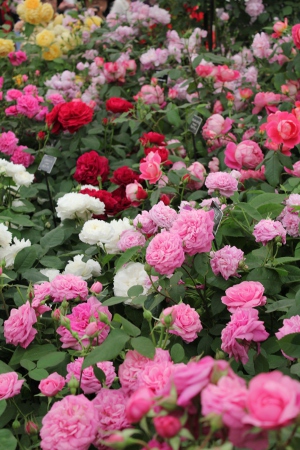|
Getting Started
With hundreds of roses available today, and new varieties being released every year it is important to understand the categories they are divided into in order to select the best rose for your garden.
- Hybrid Tea: These roses have large blooms on tall stems making them ideal for picking.
- Floribunda: Floribunda roses have an abundance of flowers all season. They have smaller blooms than hybrid tea roses, but they have up to 12 flowers per stem.
- English: English/ David Austin roses were bred by the Englishman David Austin. These roses combine the flower structure of modern roses with the fragrance of old fashioned roses.
- Climbers: The flowers of climbing roses come in all sizes and colours. Many are fragrant. These roses make a fabulous display.Use them to cover walls, fences, pergolas and archways.
- Patio: Patio or miniature roses are compact with small flowers and well suited to containers.
- Standards: These are roses on a on a 800cm stem and make a great design statement in all gardens. Many of the hybrid tea, floribunda and English roses can be purchased as a standard.
When to plant
The main rose planting season is winter when the plants are dormant. However roses can be planted right through spring into summer. New seasons roses are arrive Queens Birthday every year.
Where to plant
Roses prefer a sunny position with a slight breeze but not a strong wind.
How to plant
Dig a hole which is twice as wide as the pot the rose is in and a little deeper. Place a handful of sheep pellets in the hole. Sheep pellets help to condition the soil and get the rose off to a good start. Plant the rose, firm the soil down and water in well. Ensure that all standard roses are staked at planting time.
Pruning
- Always prune a new rose plant. Prune to an outward facing bud and remove any spindly or crossing over growth. Prune back hard to about 15 cm high.
- Existing bushes, standards and climbing roses should be pruned yearly in July. Remove all dead or diseased wood. Prune back each main cane by half and ensure that the centre of the plant is open.
- When pruning climbing roses, tie up long shoots and cut back by 3 buds. Cut out any cross over branches.
- Roses are very forgiving plants, so don’t worry if you think you have pruned them back too hard.
Feeding
- Roses are hungry plants. Feed with Tui Rose Fertiliser from Spring through to March in Autumn.
- Apply Tui Sulphate of Potash in May to harden the canes before winter.
- A dash of lime in winter will keep the soil healthy and therefore your plants healthy.
Plant Protection
Roses require a regular spray program to stay lush and healthy. Follow the spray program below to prevent pests and diseases from attacking your roses.
- Aphids usually appear on the rose buds and if there are only a few they can be squashed.
- Scale can appear on both the leaf margins and canes.
- Black spot is a common fungal disease attaching rose leaves.
When in leaf, do not spray in the heat of the day as leaves may scorch. Always spray on still days.
| Month | Products |
|---|
| May | Yates Champ Copper with Yates Conqueror Oil |
|---|
| June | Yates Lime Sulphur |
|---|
| July | Yates Champ Copper with Yates Conqueror Oil after pruning |
|---|
| August | Yates Shield or Yates Super Shield. Apply at 2-3 week intervals throughout spring and summer. |
|---|
Tending
Keeping the plant strong and healthy will help it to ward off pests and diseases. When watering make sure the ground is watered and not the foliage to stop the spread of moisture which is how black spot spreads. Pick up and burn leaves as they fall to prevent the spread of pests and diseases. Mulch around the plant to help conserve moisture but keep clear of the stem.
Flowering
Dead heading the rose bush will help to promote continuous flowering.
|









